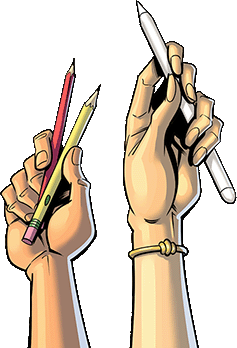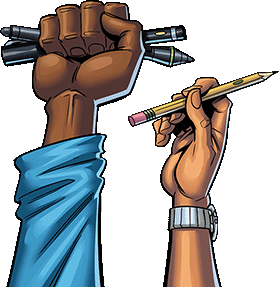12 Common Myths About Self-Publishing a Graphic Novel
November 29, 2022
In recent years, the publishing industry has been turned on its head with the rise of self-publishing. This is especially true in the world of comic books and graphic novels, where indie authors have more resources than ever to work outside the traditional publishing system.
However, even as self-published graphic novels become more popular, a few harmful myths persist about self-publishing in the comic book industry.
- Self-Publishing is a Vanity Project
Too many people in literary circles still see the self-publishing route as nothing more than vanity publishing. They mistakenly believe that self-published and indie authors are acting out of ego to see their name in print, while the “real” authors go through the traditional channels to get their works published.
Indie comic book authors have as much dedication and work ethic as those who publish their graphic novels through traditional publishing houses. In fact, given the amount of work and effort that self-published authors need to succeed in the indie world, the self-publication route often requires much more passion and dedication.
- Self-Publishing is Less Prestigious than Traditional Publishing
Traditional publishing is often perceived as having more prestige than self-publication. This is partly based on the belief that the self-publication system is a free-for-all, while traditional publication grants the esteem of discerning editors and industry professionals.
However, even before the rise of the self-publishing system, traditional publications for comic books and graphic novels were always based on arbitrary estimations of what would be more profitable or appeal to a particular audience.
- Self-Published Authors Do Less Work
Self-publishing a comic book or graphic novel takes dedication and skill. When working outside the traditional publishing industry, self-published comic authors often have more tasks to perform independently. When working with a traditional publishing house, things like formatting, printing, and marketing are usually handled in-house by professionals, not the author themself.
Self-published authors usually need to take these matters into their own hands, often needing to learn new skills. This has numerous benefits, including greater freedom, more say in the final product, and a larger share of the final profits from the book. However, it also means that self-published authors often have to do more work than traditionally-published authors.
- Self-Published Authors Have Fewer Marketing Options
The conventional system for marketing graphic novels is tied up with the traditional publishing industry. Some people wrongly assume self-published authors have fewer avenues to market their comics and graphic novels.
Social media, Amazon, email marketing, and other innovative platforms provide self-published authors with several possibilities for marketing their graphic novels. While these marketing options require more work on the author’s part, they can provide better means of building a loyal audience than the traditional publication process would allow.
- Social Media Makes Marketing Too Easy
Another myth suggests that self-published comic authors have it too easy when it comes to marketing, thanks to social media. Some people believe that self-published authors can put up one Facebook post or send out a Tweet and then just sit back and let the royalties pour in.
While social media does provide self-published authors with an innovative and exciting route to market their comics, it also requires a significant amount of extra work to meet their bottom line. For self-published authors, social media marketing can become a second full-time job in addition to writing and illustrating.
- Self-Published Authors Make Less Money
In both the traditional publishing industry and the self-publishing industry, the amount of money you make varies. But there’s no reason to believe that you will always make less money through self-publishing. In fact, in some cases, you can see higher profits from self-publishing than from traditional publishing.
While it’s true that traditional publishing houses may provide you with market services and exposure, there’s no guarantee that your graphic novel will perform well with them. This is especially true since you will have less say in how you market your book, and your publisher may fail to connect your work with the best audience.
Self-publishing allows you to promote your work to the audience that you think would best connect with it. This can lead to better sales in many cases than if a large publishing house promotes your work.
Self-publishing means that you will see a much larger share of the profits that your work brings in. Comic book authors that traditionally publish their work often see as much as 95% of royalties from publication taken by the publishing house to cover marketing, publication, and other overhead costs.
Self-published authors usually handle these things themselves and therefore get to keep much more money from sales.
- Print Books Are More Professionally Made
Self-published graphic novels vary in quality more than those put out by traditional publishers. But this does not mean that self-published authors do not have the resources to put out graphic novels of the same quality as those of major publishing houses.
By using excellent publishing partners like Comix Well Spring, self-published comic authors can benefit from online resources to help them format and publish their works with all the same professional elements as graphic novels published professionally
With Comix Well Spring, your work can have a high-quality book cover, professional-grade paper, and printing indistinguishable from traditional comic publishers.
- Authors with Self-Published Works Will Never be Accepted by Traditional Publishing Houses
Some comic authors considering self-publication may fear that self-publishing a work early in their career may hurt their chances of getting work accepted by a traditional publishing house. But while traditional publishers may have dismissed self-published authors in the past, the rising success of self-published comics changed that perception.
Both the traditional publishing and self-publishing industries are looking to maximize sales. Successful self-published comic authors already have an established audience and track record of success that traditional publishers are always on the lookout for.
A successful track record of self-publication may increase your chances of getting published by a larger publishing house. Not only will it get your name out there, but the publishers will feel more confident investing money and resources in your work if you already have a dedicated audience.
- The Market for Indie Authors is Too Niche
While the market for indie and self-published comic authors may be niche, comic and graphic novel fans tend to have more particular tastes, so even traditional graphic novel publishers often market towards specific, niche audiences.
These audiences always look for high-quality comic books in their preferred genre, including comics from self-published or indie authors. Self-publishing your graphic novels won’t prevent you from accessing traditional publishing audiences; you’ll have more opportunities to build a following with these audiences on your terms.
- Traditionally-Published Authors Have a More Sophisticated Audience
Audience sophistication is an entirely subjective quality. If someone chooses to view any self-published graphic novel as less sophisticated by default, there’s little you can do to change their mind.
But dedicated comic fans are more often seeking high-quality works from traditional publishers and self-publishers. And with this current overlap, subjective opinions of audience sophistication are becoming less relevant.
- ebook Sales Don’t Count as Real Sales
Many self-published authors publish their graphic novels as ebooks rather than paper-and-ink books. But while ebooks are beginning to represent a larger share of the self-published comics market, some people believe that ebook sales don’t count as actual sales.
However, successful marketing of graphic novel ebooks requires just as much work and resources as marketing physical graphic novels.
An ebook author will need to put in as much work into drawing, coloring, formatting, and building an audience as they would for a physical book. And the money from ebook sales is just as real as from physical book sales.
- Self-Published Authors Have No Resources to Succeed
Some comic authors who are considering self-publication may fear that they have no resources to succeed. But thanks to excellent industry partners like Comix Well Spring, all self-published comic and graphic novel authors can get the tools, tips, and printing services they need to excel in the self-publishing world, no matter where they are in their publication journey.
Comix Well Spring offers superb comic book, comic strip, and graphic novel printing services to all independent comic creators. With quick 2-week turnaround times, rush delivery options, and free templates, Comix Well Spring provides all the resources an indie comic author needs to get their foot in the door.

Partner with Comix Well Spring to Bring Your Comic to Life
If you have written a book, comic, or graphic novel, or plan to write a book in the future, call Comix Well Spring at (734) 927-0044 to get started today. Our website offers helpful articles, writing and illustrating tips, and user-friendly ordering pages. We also offer a platform to sell your comic books, both digital and print versions, and help you connect with a broader audience.


